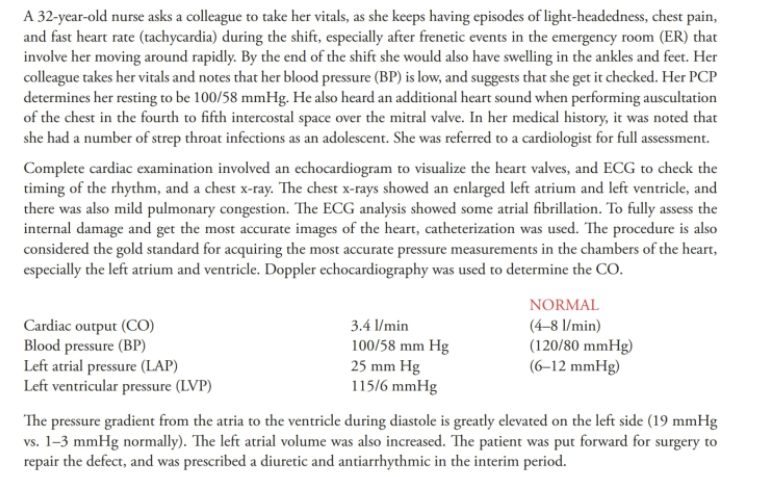Describe the basics of blood flow through the cardiovascular system – through the heart, pulmonary and systemic circulations.
Describe the basics of blood flow through the cardiovascular system – through the heart, pulmonary and systemic circulations.
Human Anatomy & Physiology (11th Edition)
11th Edition
ISBN:9780134580999
Author:Elaine N. Marieb, Katja N. Hoehn
Publisher:Elaine N. Marieb, Katja N. Hoehn
Chapter1: The Human Body: An Orientation
Section: Chapter Questions
Problem 1RQ: The correct sequence of levels forming the structural hierarchy is A. (a) organ, organ system,...
Related questions
Question
baDescribe the basics of blood flow through the cardiovascular system – through the heart,
pulmonary and systemic circulations.
b. Define how cardiac output is calculated, and what it can tell you about heart function and metion factors that influence cardiac output to maintain adequate perfusion?
c. How is one-way flow through the heart achieved and What are the stages of the cardiac cycle and the changes in pressure that occur in the
chambers?

Transcribed Image Text:A 32-year-old nurse asks a colleague to take her vitals, as she keeps having episodes of light-headedness, chest pain,
and fast heart rate (tachycardia) during the shift, especially after frenetic events in the emergency room (ER) that
involve her moving around rapidly. By the end of the shift she would also have swelling in the ankles and feet. Her
colleague takes her vitals and notes that her blood pressure (BP) is low, and suggests that she get it checked. Her PCP
determines her resting to be 100/58 mmHg. He also heard an additional heart sound when performing auscultation
of the chest in the fourth to fifth intercostal space over the mitral valve. In her medical history, it was noted that
she had a number of strep throat infections as an adolescent. She was referred to a cardiologist for full assessment.
Complete cardiac examination involved an echocardiogram to visualize the heart valves, and ECG to check the
timing of the rhythm, and a chest x-ray. The chest x-rays showed an enlarged left atrium and left ventricle, and
there was also mild pulmonary congestion. The ECG analysis showed some atrial fibrillation. To fully assess the
internal damage and get the most accurate images of the heart, catheterization was used. The procedure is also
considered the gold standard for acquiring the most accurate pressure measurements in the chambers of the heart,
especially the left atrium and ventricle. Doppler echocardiography was used to determine the CO.
NORMAL
Cardiac output (CO)
Blood pressure (BP)
Left atrial pressure (LAP)
Left ventricular pressure (LVP)
3.4 l/min
100/58 mm Hg
25 mm Hg
115/6 mmHg
(4-8 l/min)
(120/80 mmHg)
(6–12 mmHg)
The pressure gradient from the atria to the ventricle during diastole is greatly elevated on the left side (19 mmHg
vs. 1-3 mmHg normally). The left atrial volume was also increased. The patient was put forward for surgery to
repair the defect, and was prescribed a diuretic and antiarrhythmic in the interim period.
Expert Solution
This question has been solved!
Explore an expertly crafted, step-by-step solution for a thorough understanding of key concepts.
This is a popular solution!
Trending now
This is a popular solution!
Step by step
Solved in 5 steps with 1 images

Recommended textbooks for you

Human Anatomy & Physiology (11th Edition)
Anatomy and Physiology
ISBN:
9780134580999
Author:
Elaine N. Marieb, Katja N. Hoehn
Publisher:
PEARSON

Anatomy & Physiology
Anatomy and Physiology
ISBN:
9781259398629
Author:
McKinley, Michael P., O'loughlin, Valerie Dean, Bidle, Theresa Stouter
Publisher:
Mcgraw Hill Education,

Human Anatomy
Anatomy and Physiology
ISBN:
9780135168059
Author:
Marieb, Elaine Nicpon, Brady, Patricia, Mallatt, Jon
Publisher:
Pearson Education, Inc.,

Human Anatomy & Physiology (11th Edition)
Anatomy and Physiology
ISBN:
9780134580999
Author:
Elaine N. Marieb, Katja N. Hoehn
Publisher:
PEARSON

Anatomy & Physiology
Anatomy and Physiology
ISBN:
9781259398629
Author:
McKinley, Michael P., O'loughlin, Valerie Dean, Bidle, Theresa Stouter
Publisher:
Mcgraw Hill Education,

Human Anatomy
Anatomy and Physiology
ISBN:
9780135168059
Author:
Marieb, Elaine Nicpon, Brady, Patricia, Mallatt, Jon
Publisher:
Pearson Education, Inc.,

Anatomy & Physiology: An Integrative Approach
Anatomy and Physiology
ISBN:
9780078024283
Author:
Michael McKinley Dr., Valerie O'Loughlin, Theresa Bidle
Publisher:
McGraw-Hill Education

Human Anatomy & Physiology (Marieb, Human Anatomy…
Anatomy and Physiology
ISBN:
9780321927040
Author:
Elaine N. Marieb, Katja Hoehn
Publisher:
PEARSON